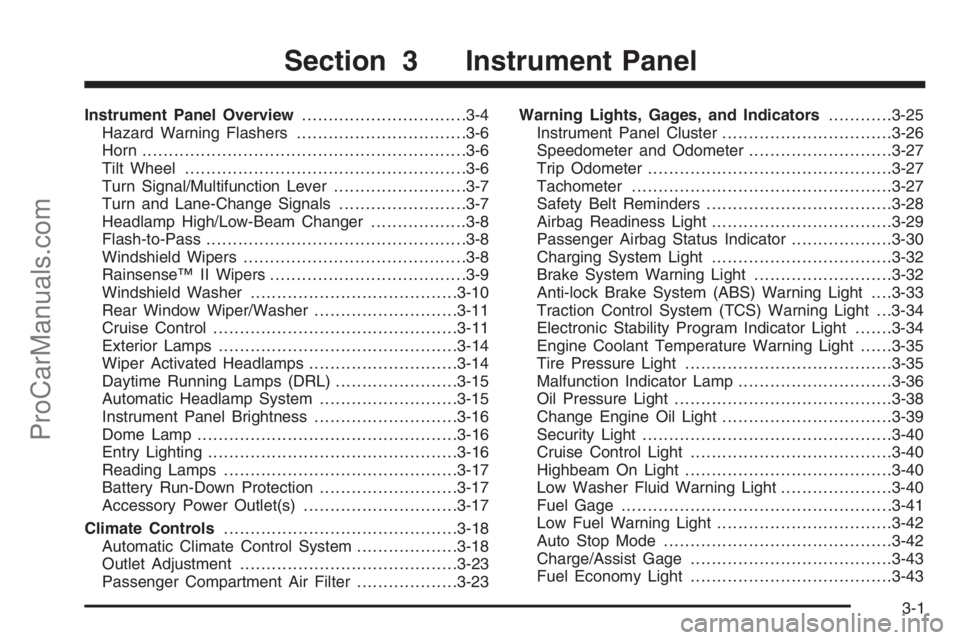lane assist SATURN VUE HYBRID 2008 Owners Manual
[x] Cancel search | Manufacturer: SATURN, Model Year: 2008, Model line: VUE HYBRID, Model: SATURN VUE HYBRID 2008Pages: 384, PDF Size: 2.56 MB
Page 121 of 384

Instrument Panel Overview...............................3-4
Hazard Warning Flashers................................3-6
Horn .............................................................3-6
Tilt Wheel.....................................................3-6
Turn Signal/Multifunction Lever.........................3-7
Turn and Lane-Change Signals........................3-7
Headlamp High/Low-Beam Changer..................3-8
Flash-to-Pass.................................................3-8
Windshield Wipers..........................................3-8
Rainsense™ II Wipers.....................................3-9
Windshield Washer.......................................3-10
Rear Window Wiper/Washer...........................3-11
Cruise Control..............................................3-11
Exterior Lamps.............................................3-14
Wiper Activated Headlamps............................3-14
Daytime Running Lamps (DRL).......................3-15
Automatic Headlamp System..........................3-15
Instrument Panel Brightness...........................3-16
Dome Lamp .................................................3-16
Entry Lighting...............................................3-16
Reading Lamps............................................3-17
Battery Run-Down Protection..........................3-17
Accessory Power Outlet(s).............................3-17
Climate Controls............................................3-18
Automatic Climate Control System...................3-18
Outlet Adjustment.........................................3-23
Passenger Compartment Air Filter...................3-23Warning Lights, Gages, and Indicators............3-25
Instrument Panel Cluster................................3-26
Speedometer and Odometer...........................3-27
Trip Odometer..............................................3-27
Tachometer.................................................3-27
Safety Belt Reminders...................................3-28
Airbag Readiness Light..................................3-29
Passenger Airbag Status Indicator...................3-30
Charging System Light..................................3-32
Brake System Warning Light..........................3-32
Anti-lock Brake System (ABS) Warning Light. . . .3-33
Traction Control System (TCS) Warning Light . . .3-34
Electronic Stability Program Indicator Light.......3-34
Engine Coolant Temperature Warning Light......3-35
Tire Pressure Light.......................................3-35
Malfunction Indicator Lamp.............................3-36
Oil Pressure Light.........................................3-38
Change Engine Oil Light................................3-39
Security Light...............................................3-40
Cruise Control Light......................................3-40
Highbeam On Light.......................................3-40
Low Washer Fluid Warning Light.....................3-40
Fuel Gage...................................................3-41
Low Fuel Warning Light.................................3-42
Auto Stop Mode...........................................3-42
Charge/Assist Gage......................................3-43
Fuel Economy Light......................................3-43
Section 3 Instrument Panel
3-1
ProCarManuals.com
Page 305 of 384

If a Tire Goes Flat
Your vehicle has a tire sealant and compressor kit.
SeeTire Sealant and Compressor Kit on page 5-68.
There is no spare tire, no tire changing equipment,
and no place to store a tire.
It is unusual for a tire to blow out while you are driving,
especially if you maintain your tires properly. SeeTires
on page 5-47. If air goes out of a tire, it is much more
likely to leak out slowly. But, if you should ever have a
blow out, here are a few tips about what to expect and
what to do:
If a front tire fails, the �at tire will create a drag that
pulls the vehicle toward that side. Take your foot off
the accelerator pedal and grip the steering wheel �rmly.
Steer to maintain lane position, and then gently brake
to a stop well out of the traffic lane.
A rear blow out, particularly on a curve, acts much like a
skid and may require the same correction you would use
in a skid. In any rear blow out, remove your foot from
the accelerator pedal. Get the vehicle under control by
steering the way you want the vehicle to go. It may be
very bumpy and noisy, but you can still steer. Gently
brake to a stop, well off the road if possible.If a tire goes �at, avoid further tire and wheel damage
by driving slowly to a level place and stopping.
Then do this:
1. Turn on the hazard warning �ashers. SeeHazard
Warning Flashers on page 3-6.
2. Park your vehicle. Set the parking brake �rmly and
put the shift lever in PARK (P). SeeShifting Into
PARK (P) on page 2-27.
3. Turn off the engine.
4. Inspect the �at tire.
If the tire has been separated from the wheel, has
damaged sidewalls, or has a puncture larger than a
1�4inch (6 mm), the tire is too severely damaged for
the tire sealant and compressor kit to be effective.
SeeRoadside Assistance Program on page 7-6.
If the tire has a puncture less than a
1�4inch (6 mm)
in the tread area of the tire, seeTire Sealant and
Compressor Kit on page 5-68.
5-67
ProCarManuals.com